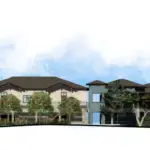CARLSBAD — The Carlsbad City Council on Aug. 27 will hear initial recommendations about strategies — including potentially increasing density — to satisfy state-mandated affordable housing planning requirements.
Increasing residential density — a.k.a. “up-zoning” to allow taller buildings — is a recurrent hot potato in local politics. Opponents frequently express concerns about added traffic, added strain to infrastructure and services, unwanted changes to an area’s architectural character and impeded views.
But in order to become financially viable for builders, lower-income housing units generally require higher densities, subsidies and/or other regulatory incentives or helps.
“When I talk to [affordable housing developers] about how they get these projects funded, … they need density in order to make it work,” Daniel Weis, a citizen member of the city’s Housing Element Advisory Committee, said at the group’s August 12 meeting.
As a rule of thumb, the state government considers 30 dwelling units per acre the minimum density to achieve lower-income affordability on a given parcel. The rationale is that, with more income-generating units, builders can spread costs — land, materials, labor, debt — while still keeping some prices low enough to be considered affordable.
For comparison, the average density on residential parcels citywide is about 7 units per acre, according to The Coast News’ previous analysis of county assessor parcel data.
While many residents “are averse to the size of a building, … there definitely is room for it in certain areas and on certain lots in the city,” Weiss said.
But “west of El Camino Real, I don’t know a citizen in Carlsbad who’s really rallying around four or five story buildings,” committee member Carl Stryker said.
“I always just hear opinions against anything above three stories,” committee member David Barnett said. He said he doesn’t oppose up-zoning categorically but prefers to see whether the city might meet its mandates through other strategies first.
In prioritizing six strategies to present to the council, the committee collectively ranked up-zoning second to last.
They preferred, in this order: (1) where existing zones allow ranges of, require developers to build at the midpoint rather than the minimum; (2) rezone city-owned properties, such as office or parking lots, for higher density residential uses; (3) convert commercial properties; and (4) approve pending development applications that are already requesting rezoning.
Behind up-zoning, the advisory committee’s least preferred strategy is to convert industrial properties to higher density residential uses.
Municipalities statewide must demonstrate periodically to the state government that they have a sufficient regulatory environment and availability of parcels to support housing production targets at various income levels. Local governments codify these policies and sites by updating the Housing Element, or chapter, of their General Plans. Carlsbad’s current Housing Element covered the period from 2013 to 2021. The update currently underway, to which apply the recommendations council will hear next week, covers the period 2021-2029.
Comparing the two update periods, even though Carlsbad must this time plan for about one-quarter fewer housing units overall, it must plan for about one-third more units specifically in lower-income categories.





2 comments
Raise the height limitation on ADU’s to allow a second story.
We need more trees as we bake in this heat.
Stop building roads and houses reflecting nothing but additinal heat into the atmosphere. They won’t be affordable anyways as developers lie and cheat to build more “luxury” homes that are nothing but the sort.
Comments are closed.